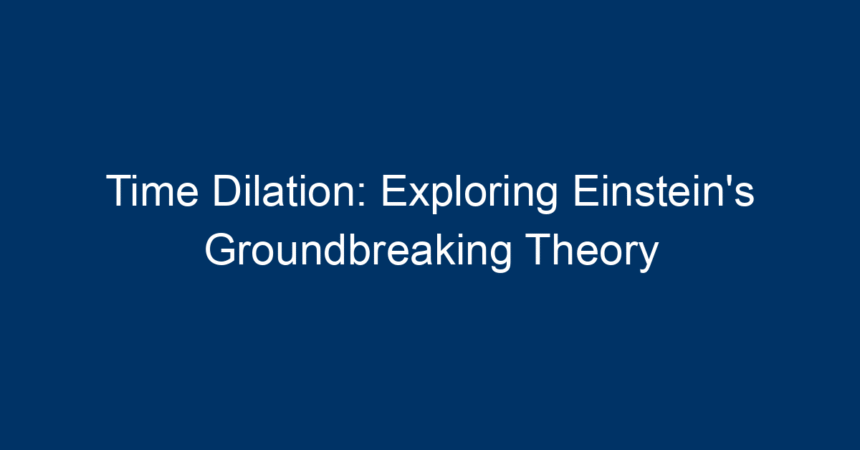Introduction
Time is a familiar concept, woven into the fabric of our daily lives. However, when we dive into the realms of physics, particularly in the context of Albert Einstein’s theory of relativity, we discover that time isn’t as straightforward as it seems. One of the most intriguing aspects of his theory is time dilation. This phenomenon suggests that time isn’t a universal constant; instead, it can stretch or compress depending on various factors, including speed and gravity. In this article, we will explore time dilation in detail, unravel its implications, and examine how it reshapes our understanding of the universe.
The Basics of Time Dilation
What is Time Dilation?
At its core, time dilation refers to the difference in the elapsed time as measured by two observers, due to a relative difference in velocity between them or the presence of gravitational fields. According to Einstein’s special relativity, time moves slower for an object in motion compared to a stationary observer. This means that time can pass at different rates for people in different frames of reference.
The Two Types of Time Dilation
-
Relative Velocity Time Dilation: This occurs when two observers are moving relative to each other at significant fractions of the speed of light. If one observer travels at a high speed, time appears to slow down for them in the eyes of the stationary observer.
- Gravitational Time Dilation: This phenomenon occurs in the presence of strong gravitational fields. According to Einstein’s general theory of relativity, the closer an object is to a massive body, the slower time passes for it compared to an observer further away. Thus, time runs slower on planets and stars compared to what we experience on Earth.
Einstein’s Theory of Relativity: A Deep Dive
Special Relativity and Time Dilation
In 1905, Einstein formulated the special theory of relativity, which states that the laws of physics are the same for all non-accelerating observers and that the speed of light in a vacuum is constant, regardless of the motion of light sources or observers. From this foundation, time dilation arises.
Imagine two twins: one remains on Earth, while the other travels through space at near-light speed. Upon the traveling twin’s return, they will have aged less than their Earth-bound sibling. This thought experiment, often called the "Twin Paradox," vividly illustrates time dilation due to relative velocity.
General Relativity and Time Dilation
In 1915, Einstein expanded his theories with general relativity, which includes the effect of gravity on time. He suggested that massive objects warp the fabric of spacetime, causing time to pass more slowly in their vicinity. This can affect everything from GPS satellites orbiting Earth to black holes, where time behaves in ways challenging to comprehend.
Real-World Applications of Time Dilation
GPS Technology
One of the most practical applications of time dilation is in the Global Positioning System (GPS). GPS satellites orbiting Earth experience both types of time dilation: their high speeds result in relative velocity time dilation, while their elevation from Earth’s gravitational pull leads to gravitational time dilation. Engineers must account for these discrepancies, which can amount to nanoseconds, to provide accurate positioning data. Without adjustments for time dilation, GPS devices would lead to significant errors, illustrating how time dilation is not just a theoretical concept but a critical component of modern technology.
Particle Physics
In particle physics, time dilation plays a crucial role. For example, muons—subatomic particles created when cosmic rays hit the atmosphere—have a very short lifespan (around 2.2 microseconds). However, when these particles move close to the speed of light, they can travel farther than expected before decaying. This is a direct consequence of time dilation: they age slower compared to observers on Earth.
Astronauts in Space
Astronauts aboard the International Space Station (ISS) experience time dilation due to their high speed and the weaker gravitational field at their altitude. This has led to measurable differences when comparing their biological clocks to those of people on Earth. Though the effect is minuscule, it illustrates time dilation’s tangible impact as we expand our exploration into space.
The Implications of Time Dilation
Philosophical Ramifications
Time dilation challenges our conventional understanding of time, urging us to reconsider our perceptions of past, present, and future. If time can behave differently in various states, what does that mean for our understanding of life, existence, and reality?
Technological Advances
As our technology improves, understanding time dilation becomes even more critical. Navigating interstellar travel, for instance, could necessitate advanced knowledge and mechanics of time dilation to ensure efficiency and safety. Theoretical explorations into time travel also hinge on concepts rooted in time dilation, urging scientists to probe deeper into the mystery of time itself.
Frequently Asked Questions (FAQs)
1. Is time dilation experienced only at relativistic speeds?
While significant time dilation becomes noticeable at speeds approaching that of light, even everyday speeds can produce tiny effects. For example, precise atomic clocks on airplanes measure slight discrepancies compared to clocks on the ground.
2. Can time dilation be observed in our daily lives?
Yes, time dilation is subtly present in daily technology. GPS systems, as previously discussed, directly incorporate time dilation corrections, affecting our navigation experiences.
3. What is the formula for calculating time dilation?
The formula for time dilation due to relative velocity is given by:
[
t’ = \frac{t}{\sqrt{1 – (v^2/c^2)}}
]
where:
- ( t ) is the time interval measured by a stationary observer,
- ( v ) is the relative velocity,
- ( c ) is the speed of light,
- ( t’ ) is the time interval measured by the moving observer.
Conclusion
Time dilation is a profound concept that reconciles our everyday experience of time with the vast complexities of the universe. From its roots in Einstein’s theories of relativity to its real-world applications in GPS technology and particle physics, understanding time dilation opens doors to fascinating possibilities about existence and time itself.
As our understanding of the universe grows, so too does the importance of time dilation in our scientific endeavors. Whether you are a science enthusiast or just curious about the nature of time, the implications of time dilation offer not just a glimpse into the vast expanse of physics, but an adventure into the mysteries of existence.
Actionable Insight: Embrace the complexities of time in your daily thinking. Consider how technology harnesses these principles. Engage with time in a new way—perhaps observe how it feels to slow down and appreciate the moments in life, reminding yourself that even in our fast-paced world, time can be fluid and different depending on perspective.




